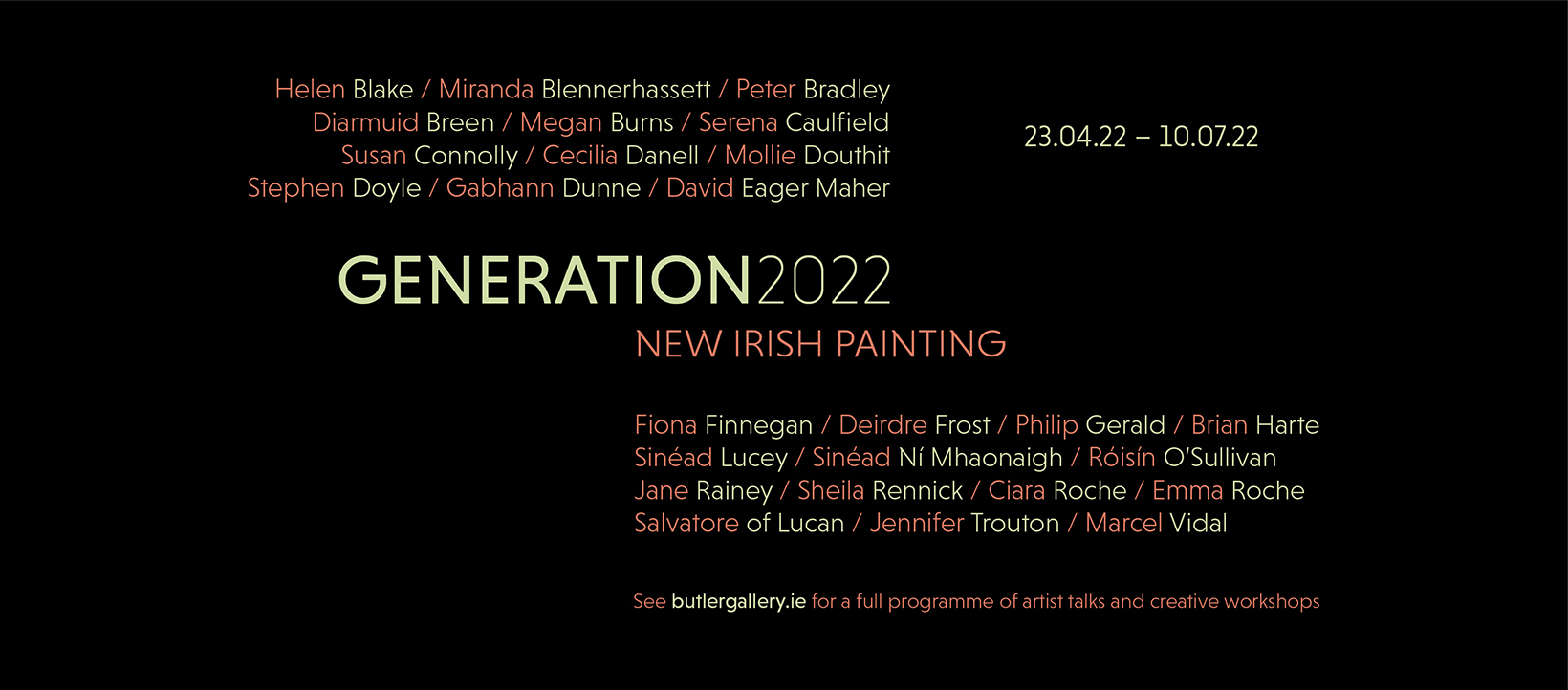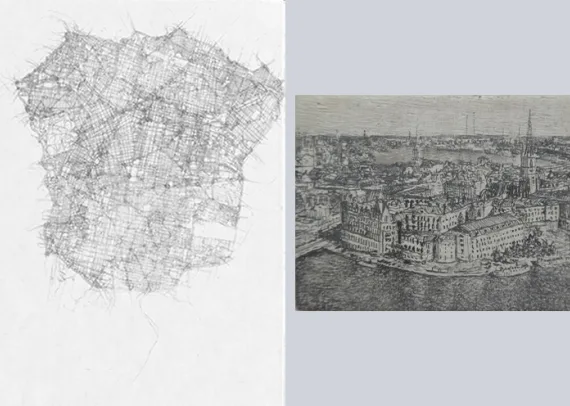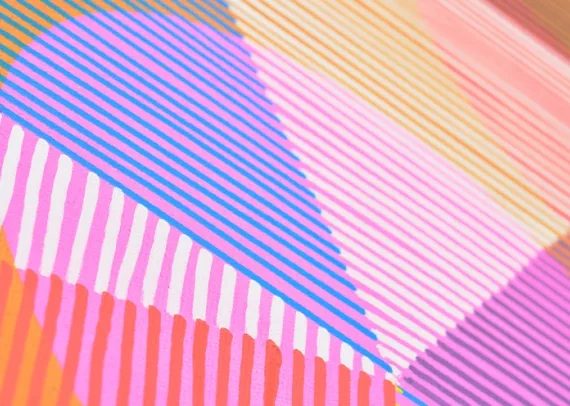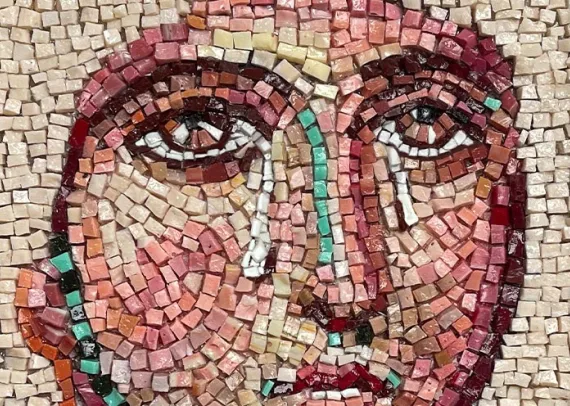-
 Apr 23 2022 - Jul 10 2022
Apr 23 2022 - Jul 10 2022
GENERATION2022: New Irish Painting, a celebration of painting and of painters at work in Ireland today.
The exhibition included site-specific installations and paintings by:
Helen Blake | Miranda Blennerhassett | Peter Bradley | Diarmuid Breen | Megan Burns | Serena Caulfield | Susan Connolly | Cecilia Danell | Mollie Douthit | Stephen Doyle | Gabhann Dunne | David Eager Maher | Fiona Finnegan | Deirdre Frost | Philip Gerald | Brian Harte | Sinéad Lucey | Sinéad Ní Mhaonaigh | Róisín O’Sullivan | Jane Rainey | Sheila Rennick | Ciara Roche | Emma Roche | Salvatore of Lucan | Jennifer Trouton | Marcel Vidal
With established or burgeoning careers, the works by the artists on view reflected a diversity of approach to painting, from abstraction to figuration, to representational work embracing landscape and portraiture. Some paintings were incorporated into installations on the wall, but mostly the works were two-dimensional explorations of the variety of the passions, issues and concerns of the individual artists. In my research for this exhibition, I visited studios in many parts of the country—from Belfast to Ballydehob—and encountered vastly different working situations. From the light-filled spaces of Queens Street Studios, I went on to view works on kitchen tables, walls of apartments, in spare bedrooms and attic spaces to a windswept chalet in West Cork. No matter where I travelled I encountered artists at work doing what they love to do. Post pandemic we were equally thrilled to be looking at and talking about art which made these visits a rich and rewarding experience. My intention when curating this exhibition was not to mount a survey of painting but to reflect a personal observation of the quality of painting I saw happening around the country. The works are hung salon-style, embracing the height of our Main Gallery while providing space to view the work of the twenty-six artists on show.
This group of exceptional painters are undeniably leaving their mark and making an impact on the contemporary art world in Ireland today. If this exhibition does nothing else I do hope it leaves you with a desire to seek out more of the individual work of these artists through their websites and galleries and to view more of their work in person—the rewards will be immense.
Anna O’Sullivan
Director/Chief Curator
___________________________________________
Helen Blake constructs meticulous paintings that record and examine colour conversations within accumulated pattern structures, embracing accidents, flaws and discrepancies within their rhythms.
Miranda Blennerhassett’s work focuses on the cultural role of pattern and decoration and their relationship to architecture, and in particular the tradition of democratically sharing methods for constructing ornament. Blennerhassett’s site-specific installation, located at the entrance to the exhibition, is inspired by photographs showing remnants of wallpaper found in the residential rooms of Evans’ Home when it operated as an alms house for retired servants. The artist uses four different pattern shapes for her stencilled installation Butler (Proto-ornaments): ‘striped, rectangular and triangular lines and freely arranged dots’ are painted onto the walls, a traditional decorative technique that also dates back to cave paintings, approximately 37,000 years ago.
Identity, gender, sex, and sexuality are prevalent themes in the work of Peter Bradley. His portraits are an analysis of identity presentation between and beyond the gender binary and a celebration of self-expression. Using transparency, light and reflectivity in his work has allowed Bradley to analyse the reciprocal relationship between the viewer, the work and the environment.
Diarmuid Breen collects photo albums found in markets and car boot sales in Belgium and France and uses them as source material to create poignant figurative paintings of people at work or play with rich narrative undertones that verge on the surreal.
Through a mathematical practice of geometric abstraction, Megan Burns uses geometry, colour and form to create abstract illusionary spaces that are suspended between the real and the imagined.
Memory inhabits the paintings of Serena Caulfield who ‘likes to think slow and paint quickly’. Her self-built studio sits on the grounds of her family home where its history and the surrounding landscape triggers much of her subject matter.
Susan Connolly’s practice pushes the physical boundaries of painting to its limits. The painting installation over+over takes its starting point in CMY colour combinations and exposes the front and back of the painting to show cuts and curls in the canvas. This work hovers between painting and sculpture and is intended to allow the viewer to experience it as both.
Cecilia Danell is a Swedish artist based in Galway. Her practice is process based, where accumulated research into landscape and the psychology of place is coupled with a strong interest in materiality and making. Her painting Make the Darkness Shine is placed just off the floor allowing us to visually enter it almost like through a wardrobe door to Narnia.
Mollie Douthit is originally from North Dakota but is currently based in rural West Cork. Her work is derived from memory and a celebration of everyday moments and personal experiences where her quirky sense of humour shifts things up. The paintings on view recall memories of her youth in the uniquely designed lake home of her beloved grandparents.
Stephen Doyle explores issues of queer identity through the relationship between figuration and the politics of representation and makes figurative depictions of LGBTQIA+ people. The painting A Gender Dysphoric Delusion is a self-portrait where their sleep demon is depicted with its head sculpted in bedclothes. This scene documents recent behavioural developments stemming from stress and anxiety, resulting in bouts of insomnia, leaving the artist questioning their gender expression and identity in a state of exhaustion.
Gabhann Dunne’s work is concerned with change and the environment and the natural world. He is represented in this exhibition by an elegantly painted Goldcrest which flutters above his portrait Into The Karst.
David Eager Maher uses imagery from the history of art, often combining historical association with the imagined. Traditional painting techniques and historical motifs are adapted and re-imagined, conjuring new narratives that traverse a host of personal and contemporary motifs. These paintings spill out onto the frame like a Howard Hodgkin painting making sure that the object’s completeness cannot be interrupted by another frame.
Fiona Finnegan’s paintings have a filmic, almost magic realism quality that are mysterious in their nature. The 19th century German Romantic painter Casper David Friedrich has been an influence on her work along with photography, as both a source for imagery and as an aesthetic reference point. This is evident in these paintings where the sepia tones are reminiscent of Victorian daguerreotypes.
The architecture of Cork City is evident in the paintings of Deirdre Frost whose work is an investigation into the physicality of being in an urban environment and how nature and the natural world is perceived through this lens.
Philip Gerald paints in a faux-naif style that replicates the aesthetic of simplistic digital illustration. His irreverent paintings frequently allude to canonical works from art history, in this case drawing on the popular 18th century French artist Francois Boucher, who painted in the Rococo style. Gerald embraces a fluorescent palette that imbues his work with a joyful and childlike spirit.
Known for his large-scale canvases that waver between abstraction and figuration, Brian Harte creates deconstructed interior settings which hold traces from his own domestic life. Using both bold and muted colours, the artist creates portals that transport viewers through a visual network that is at once intimate and private, but also familiar and universal.
Drawing from life and exploring painting as a spatial experience are central to the artistic practice of Kilkenny-based Sinéad Lucey. The broad brushstrokes of the two landscape paintings on view draw you inwards and offer the viewer a means of observing their own shifts in perception; transitions that can resonate optically, physically and emotionally.
Sinéad Ní Mhaonaigh is innately concerned with the material qualities of paint and the physical act of painting itself. She suggests rather than represents. Ní Mhaonaigh’s paintings achieve an ‘opening up’ of landscape to consider universal themes of language, ancestry, and timeless depictions of place.
Róisín O’Sullivan’s process-based practice stems from her own experience of nature but slips into abstraction through intuition, experimentation and mark-making within the studio process.
Drawing inspiration from Romanticism and traditional Japanese landscape painting Jane Rainey’s otherworldly paintings express our longing for escape into nature, tapping into a sense of magic and the inner self.
Sheila Rennick’s work explores the fractures between high art and low culture, harnessing the qualities of rich impasto oil painting to produce satirical works that transgress those conventions.
Ciara Roche's small-scale oil on paper paintings are devoid of people, encouraging the viewer to inhabit the paintings and create the narrative. This group of works are moody and atmospheric and are based on scenes from iconic Hollywood noir movies like The Virgin Suicides, Mulholland Drive, Old Country for Old Men and Erin Brockovich. While made quickly, the works have an attention to detail and treatment of light and colour that brings these worlds to life.
Emma Roche’s works shift between the figurative and the abstract combining knitting or tapestry methodologies and painting to create layered and textured works. Her knitted-paint paintings and rugs are made by forming long lines of paint, extruded through a syringe. Once the paint has dried, the artist uses it as if it is wool or thread. Roche firstly maps her knitted paintings on paper, creating detailed grid patterns that partly guide her manipulation of paint which she pushes to its limits.
Exploring home, identity and relationships Salvatore of Lucan creates expansive domestic scenes that chronicle his twenty-something life where realism meets the uncanny, and the familiar broaches the magical. The painting Me and my Dad in McDonalds, 2018 is a representation of his first ever meeting with his Bangladeshi father in New York. His painting Maya, 2022 show his astute portrait skills echoing the spareness of works by artists such as Egon Schiele or Alice Neel.
Jennifer Trouton is a Belfast-based figurative painter who deliberately uses the tools and materials of the past to subtly express ideas around gender, class and identity within Irish history; combining an interest in the mythological and historical with personal narrative. Her wall installation In Plain Sight forms part of a larger body of work called One of Many in which Trouton considers the women impacted by societal and religious attempts to suppress reproductive rights in Ireland. The work highlights, how, regardless of continued attempts to reduce the influence and autonomy of women, women still accessed the tools necessary to control their own reproductive destinies. In many cases, they found the objects of their own emancipation in the domestic spaces that were assigned to them.
Marcel Vidal takes on the gallery space itself with a bold orange splash inhabiting one corner of the gallery where two paintings Breather I and Breather II are placed. Vidal’s paintings are marked by their controlled brushwork, layering oil on linen with delicacy and precision. His minimal compositions are cropped to reveal only a sliver of their subject, using ambiguity to contest interpretation, all while inviting our curiosity.
A special thanks to our all Friends and Supporters.
_______________________________________________________________________________
GENERATION2022: New Irish Painting - Visitor Feedback
Video by Maria Kennedy







 Opening Hours
Opening Hours